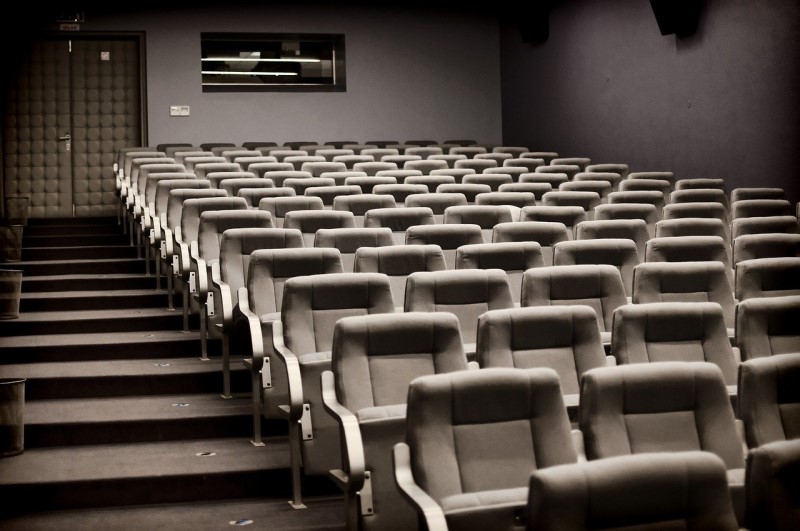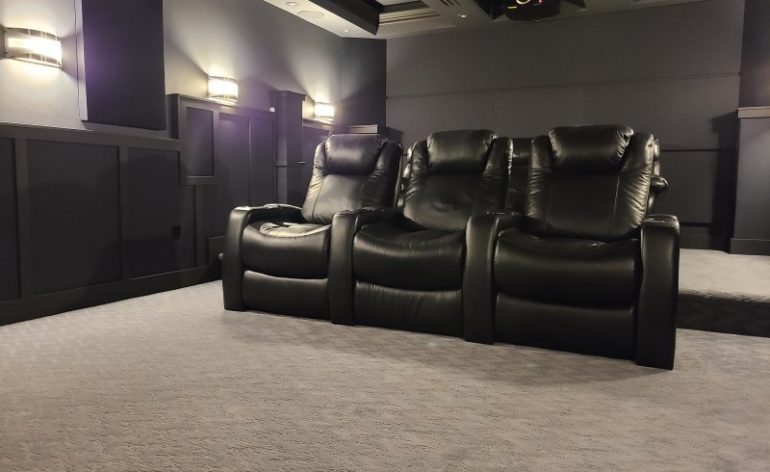Home Theater 101: Picking the Perfect Seats
When someone says the words “home theater,” a specific image comes to mind. A projector, a dark room, and a specific type of seat. One that reclines, has its own cup holder, and has an identifiable aesthetic. We get that. But when you start looking for the perfect home theater seats, don’t shop with your eyes. Shop with your butt. But, beyond that, there are some considerations you should keep in mind.
Sit Before You Buy
This sounds like a no-brainer, but “home theater” seating isn’t always readily available. You can go to a dozen stores and only find four or five options. Places like that usually only carry the home theater-style seating that is very pricy and very limited. You’ll be tempted to buy something online that is cheaper and has more options.
I personally bought home theater seating from a brochure. My wife and I sat in seats in a showroom from the same manufacturer and liked them. We thought we would be safe buying ones that were more our style.
We were wrong.
I’m not a tall man and the seats I ordered were apparently built for pro basketball players. The headrest was too high for my head but still low enough that I couldn’t rest my head on the back of the seat. So it sort of propped up my head uncomfortably. Don’t make that mistake.
If you cannot find your perfect home theater seats locally, be prepared to ask a lot of questions. See if the manufacturer has a customer local to you that would allow you to test out the seats. Tell them your height and weight and ask if they have someone similar that can “pose” with the seats so you have a better idea of the scale. Lastly, be prepared to return them if they are not what you want. Which probably means eating the shipping and restocking fees. Better that than living with terrible seats.
Style: Couch vs Recliner

When picking the perfect home theater seats, you’ll be tempted to limit your choices to a particular style. Don’t. These days, you can find many options in sectionals. They may look like a traditional couch on the showroom floor, but if you look through the brochure, you can mix and match to make something that looks and acts more like home theater seating.
That said, if your home theater is going to be used only for watching movies, the traditional recliner is what you probably want. The cupholders are nice. Just make sure they are lined with stainless steel and are easy to remove for cleaning. We’ve seen some of the cheaper options that get moldy and gross and aren’t very easy to clean.
If your home theater area is going to get more generalized use, consider a more traditional couch. You can mix and match the pieces of a sectional so that the whole thing reclines. This gives you the ability to snuggle with your special someone or lay down if you want.
Features: Power vs Manual Recline
One feature that many recliners have these days is power recline. The leg-rest comes up, sometimes the head-rest slides into place, and the experience is so very cool. I’ve got power recline on two of the three seats (they are very large seats, we can sit our family of five on this couch) in my home theater. If I had had the option, all three seats would be power recline. But most center seats don’t have a power recline option (no arm to put the controls on). This gives me the ability to compare and contrast the two.
If you ask a home theater seating manufacturer (and I did), they’ll tell you that the number one way to break a recliner is to not fully retract the leg rest. With manual recline, this isn’t much of an issue. But with power recline, if the leg rest isn’t fully retracted, the power function keeps it in place. While this isn’t as much a problem with responsible adults, it is a constant struggle in my house to get the kids to retract the leg rests. Heck, half the time they want to sit on them.
With manual recline, you’ll definitely want to test it out before you buy. I’ve had recliners with manual recline that would stay in one of two positions – legs out but back erect, and fully reclined. Any of the positions in between were impossible to maintain. Other couches have had enough fine control that you could push them into the perfect position and they’d stay. Again, a reason for sitting before you buy. It may look like the perfect home theater seats, but you won’t know for sure until you try them out.
Covering: Leather vs Fabric

While the leather look is almost always what is featured in home theater pictures, don’t assume that leather is right for you. There are lots of articles out there to help you choose between leather and fabric couches. Feel free to Google them. We do have a couple of considerations that are specific to home theaters.
First, projectors can make a room very hot. Leather isn’t the best material to sit on when the room warms up. Fabric, on the other hand, stains much more easily. As you are likely to be eating in your home theater (greasy popcorn no less), fabric may not be the best choice. With drinks being often consumed, the cup holder might save you from an unnecessary spill though, as we mentioned, they can get kinda gross if you don’t clean them regularly. Of course, cost is an issue. Just about any seating in a home theater is destined to get damaged eventually. So you might want to choose a covering so that you won’t be upset when the kids spill on it.
Multiple Rows of Seats

One thing we hear from many people is that they want multiple rows of seats in their home theaters. Even if they rarely plan to use them, they want that second row. While this has many implications for your home theater, especially in the placement of speakers, when shopping for seats, you have to keep a couple of things in mind. First, home theater seating can be very expensive. If you’ve got the money, feel free to burn it on seats you’ll never use. But if you are like most of us and you wouldn’t mind saving a little, you can buy less expensive seating for the unused row. When you have the rare occasion what someone comes over, you can give them the “good” seats and you can sit in the loser’s row.
More importantly, you probably don’t have as much room for a second row as you think you do. Depending on the type of seating you are buying, you’ll want to budget at least six feet from the back of the first row to the back of the second. This gives you enough space to walk through when the first row is reclined. It’ll still be tight, but you can do it. If you want to recline the second row, you’ll need extra space behind that couch to allow for the recline. Plus, you now have to worry about sightlines to the screen. This means you’ll need to think about raising the second row or building a riser.
For all these reasons, you might consider rotating your home theater 90 degrees. This means that the long dimension is side to side, and the short side is front to back. While this will affect your speaker placements and throw distance of your projector, it will allow you to have a much wider couch. This gives you the ability to seat more people in that single row.
Conclusion
While we didn’t tell you the “perfect” home theater seats, we hope you now are armed with enough knowledge to pick out the perfect ones for you. Beyond fitting the seating to your style, use, and color, you really need to know that the seats will work for you personally. Test out everything you can and make sure that you’ll be comfortable with what you buy. Seating can make or break your home theater experience. Shop smartly and you’ll end up loving your seats.


